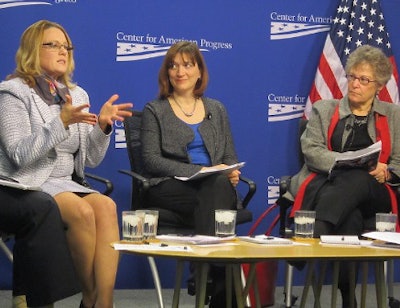 (Left to right) Yvonne Simon, Chief Learning Architect of the InnovationLab at Southern New Hampshire University; Becky Klein-Collins, Director of Research at the Council for Adult and Experiential Learning; and Jamienne Studley, U.S. Education Department Deputy Under Secretary, participate in a Center for American Progress event on competency-based education. (photo by Ronald Roach)
(Left to right) Yvonne Simon, Chief Learning Architect of the InnovationLab at Southern New Hampshire University; Becky Klein-Collins, Director of Research at the Council for Adult and Experiential Learning; and Jamienne Studley, U.S. Education Department Deputy Under Secretary, participate in a Center for American Progress event on competency-based education. (photo by Ronald Roach)WASHINGTON – In an effort to bring new ideas and policy recommendations to the ongoing national discussion on higher education reform, the Center for American Progress think tank released a pair of reports Wednesday that highlight three higher education reform models.
In “A Path Forward: Game-Changing Reforms in Higher Education and the Implications for Business and Financing Models” and “Meeting Students Where They Are: Profiles of Students in Competency-based Degree Programs,” Center for American Progress (CAP) officials put forth reform ideas “to improve and strengthen the connection between higher-education systems and employers, and urges an ‘all-of-the-above’ approach to boost program completion, reduce educational costs, and improve the overall quality of the nation’s postsecondary education system.”
David Bergeron, the CAP vice president for postsecondary education, describes the traditional approach in U.S. higher education as highly limiting in that it expects students to cram their educations into “preset credit hours and academic calendars.”
“By making learning student-centric and providing program flexibility, students can flourish within an academic setting that rewards demonstrated competencies and allows students to build off of prior learning,” Bergeron said in a statement.
“A Path Forward,” written by Bergeron, presents three approaches that “hold significant promise” for improving U.S. higher education. They are Guided Pathways to Success, stackable credentials and competency-based learning. In “Meeting Students Where They Are,” authors Rebecca Klein-Collins and Elizabeth Baylor examine competency-based education and document the experiences of students who have opted for competency-based degree programs.
During a public CAP forum event on Wednesday, federal education officials, along with reform advocates and practitioners, focused largely on the competency-based education idea and its practice at Southern New Hampshire University, one of several U.S. higher education institutions practicing competency-based education.
“This study exemplifies that we are looking at new things in this country. Competency-based education has been around for a long time but it hasn’t been looked at in-depth,” U.S. Education Department Under Secretary Martha Kanter said during the CAP event.
Under a competency-based model, students are evaluated on their application of knowledge and awarded degrees or other credentials based on proven skills and expertise. Competency-based learning allows higher education institutions to get beyond the limits of credit hour measurements, instead providing alternative means of educational delivery that can shorten the time and cost of earning a degree. In addition, schools can provide transcripts to employers that describe practical skills and abilities that students attain under competency-based programs.
“[Competency-based education] really has been on the sidelines in terms of the public understanding of why this is important, where we are going with it, and what does it have to do with quality and the kinds of outcomes we want for every student,” Kanter noted.
Under the Guided Pathways to Success, or GPS, model, students move through postsecondary education to careers by following timetables of tightly structured semesters and systems. The heavily coordinated paths enable staff and faculty members to identify those students who are falling behind so that advisers can intervene in a timely, effective manner, according to CAP.
In addition, A Path Forward recommends stackable credentials, which are defined as certificates, degrees or other formal education awards that serve as one of a sequence of credentials. For example, stackable credentials could be granted to a nursing assistant seeking to advance his or her career by becoming a registered nurse. Under existing accreditation systems, however, that student would likely be required to repeat parts of his or her training, which present time and financial barriers for many working adults.
CAP urges “policy solutions that do not require congressional action that could accelerate the pace and acceptance of reforms with clear and significant implications for students, employers and, ultimately, taxpayers,” according to A Path Forward.
“Specifically, we call on the U.S. secretary of education to design and implement experiments authorized under federal student-aid programs and urge the adoption of quality metrics against which innovative strategies can be assessed. Finally, we urge greater stakeholder—organized labor, employers, and philanthropic organizations—involvement in higher-education innovation,” writes Bergeron.

![Mentor Mentee [60287]](https://img.diverseeducation.com/files/base/diverse/all/image/2024/04/Mentor_mentee__60287_.662959db8fddb.png?auto=format%2Ccompress&fit=crop&h=100&q=70&w=100)



















